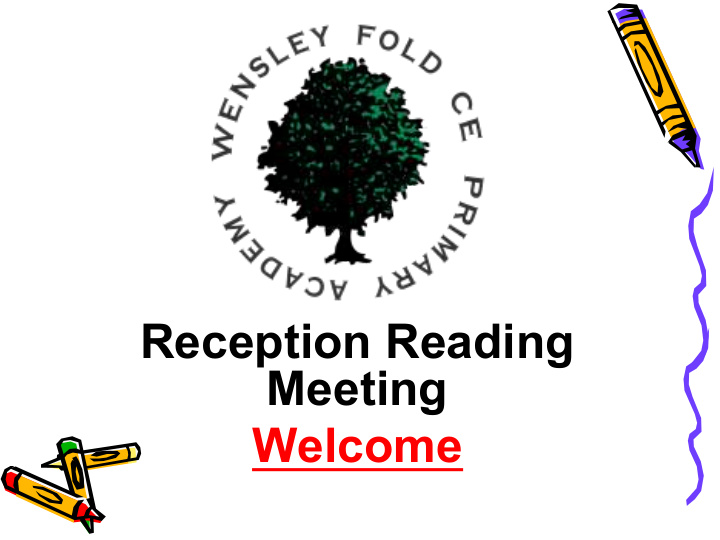



Reception Reading Meeting Welcome
Why are we here today? • How school teaches your child to read. • What you can do to help.
How do children learn to read? • Phonics • Tricky words • Picture cues • Internal understanding of how sentences are structured.
Phonics 4 Basic Skills 1. Learning the letter sounds. (Phoneme) 2. Hearing sounds within words. (Segmenting = writing) 3. Blending the sounds together to make a word. (Blending = reading) 4. Letter formation. (learning what the letter looks like and the sound it represents: grapheme)
How do we teach phonics within school?
Phonemes • The smallest unit of sound in a word. • There are 44 phonemes that we teach. • Important to understand – it’s the sound, not its letter name. Where can I go to get help with what the phonemes sounds like? http://www.youtube.com/watch?v=- ksblMiliA8
Phonics 4 Basic Skills 1. Learning the letter sounds. (Phoneme) 2. Hearing sounds within words. (Segmenting = writing) 3. Blending the sounds together to make a word. (Blending = reading) 4. Letter formation. (learning what the letter looks like and the sound it represents)
s a t p i n m d g o c k ck e u r h b f ff l ll ss j v w x y z zz qu ch sh th ng ai ee igh oa oo ar or ow oi ear air ure er
BLENDING • Initially we teach children to hear sounds and blend together. Then … • Once they have learnt the first set of sounds we then practice blending them together from left to right. For example s-u-n
SEGMENTING IS • ‘Chopping Up’ the word to sound it out • The opposite of blending • We use Robot Talking e.g m-a-n
Please encourage your child to practise their sounds and actions in their phonics folder.
How do children learn to read? • Phonics • Tricky words • Picture cues • Internal understanding of how sentences are structured.
TRICKY WORDS • Words that you can not use phonics to help you work them out. • e.g. was, the • Your child will be sent home a bookmark to practise these words.
How do children learn to read? • Phonics • Tricky words • Picture cues • Internal understanding of how sentences are structured.
Picture Cues
Reading Books • Bring reading book bag to school every day . • Please sign or make a comment in reading record each time you listen to them read (at least three times a week).
What will my child bring home?
How do children learn to read? • Phonics • Tricky words • Picture cues • Internal understanding of how sentences are structured.
Internal understanding of how sentences are structured.
Bedtime Stories
How you can help at home
• Talking and listening. • Reading with and to your child • Playing listening games such as I spy and oral blending robot talk c-a-t • Singing songs and rhymes
Where can I find resources to help? • Internet games - www.phonicsplay.co.uk www.bbc.co.uk/cbeebies (Alphablocks or youtube – jollyphonics) • Online books- www.oxfordowl.co.uk • School Website - www.wensleyfold.co.uk Check out our Reception Class Pages • Youtube – Geraldine the Giraffe
Bedtime readers – We are in the process of purchasing a lot of lovely picture books that you can take home and read to your children. Library – any children’s book is a good book preferable rhyme book, Juila Donaldson!
What do we do in school to help you? • Rhyme Time on Friday in the hall- younger siblings welcome • Story Time on Monday afternoons • Phonics Support with Mrs Patel
Any questions? Thank you very much for coming.
Recommend
More recommend